What Separated the Turtle Winners and Losers?
I am an entrepreneur, author, educator and trader. I have been consulting to individual investors and traders, hedge funds and banks since 1997. My first book was “Trend Following: How Great Traders Make Millions in Up or Down Markets”. It profiled great trend following traders who have won millions if not billions in the market. My second book “The Complete TurtleTrader: The Legend, the Lessons, the Results” is the definitive inside look at the legendary trader Richard Dennis and his student traders “The Turtles”.
Perhaps you have heard of the Turtle story, perhaps not. Either way, this unique trading legend of the last 25 years has some serious holes worth investigating. Those holes can only help traders and investors increase the odds of making that big money dream come true. But before I dig into one of those “holes” it is worth considering the root of all of this Turtle jargon.
Richard Dennis was an iconoclast, a wildcatting Chicago trader who was never affiliated with a major investment bank or Fortune 500 firm. In 1983, by the time he was 37, hed made hundreds of millions of dollars out of an initial grubstake of a few hundred dollars. As the locals were fond of saying on Chicago trading floors, Dennis bet his left nut and made a fortune.
He made that fortune on his own terms in less than fifteen years with no formal training or guidance from anyone. He took calculated risks leveraging up huge amounts of money. If he liked a trade, he took all of it he could get. He viewed the markets as a betting business. Unlike the general public, influenced by their emotions when making market decisions, Dennis avoided that dilemma by developing mathematical tools to calculate risk and then use it to his advantage. He bought and sold every market under the sun from coffee to gold to stocks to oil.
That story in itself is pretty damn impressive, but it was Dennis “teaching” story that really made him a legend. His “Turtles” cemented his place in Wall Street history. What are Turtles? In the fall of 1983 Dennis bet his then partner William Eckhardt that he could teach beginners with no experience how to trade to make millions in the same way he had. His partner scoffed saying that great traders were born, not bred. The two men decided to find out who was right. They hired and trained students nicknamed the “Turtles” (the name came after Dennis visited a Turtle breeding farm and decided to grow traders like they grew turtles). Donald Trumps “Apprentice” television show is a pale imitation of the nurture beating nature experiment Dennis created 25 years earlier.
The results? Dennis experiment worked. He and his partner were able to hire and then teach novice students to make millions. Dennis trading rules were based on observable, empirical, measurable evidence, and subject to laws of reasoning. The philosophy was based on the seven steps of the scientific method:
1. Define the question.
2. Gather information and resources.
3. Form hypothesis.
4. Perform experiment and collect data.
5. Analyze data.
6. Interpret data and draw conclusions.
7. Publish results.
The Turtles learned to ask themselves a few core questions about the markets they traded:
1. What is it the state of the market? The state of the market simply means. “What is the price that the market is trading at?” If Microsoft is trading at 40 a share today, then that is the state of that market.
2. What is the volatility of the market? Bill Eckhardt taught the Turtles that they had to know on a daily basis how much any market goes up and down.
3. What is the equity being traded? The Turtles had to know how much money they had at all times, because every rule they would learn adapted to their given account size at that moment.
4. What is the system or the trading orientation? They were taught precise rules that would tell them when to buy or sell any market at any time based on the movement or trend of the price.
5. What is the risk aversion of the trader or client? Risk management was not a concept that the Turtles grasped immediately. For example, if they had $10,000 in their account, should they bet all $10,000 on Google stock? No.
But that part of the story, that quick simplified synopsis of the Turtles rules, ended in 1988. Since then, over the last 20 years, some Turtles have continually won big and others have been far from a success. In turns out that those famous trading rules alone were only half the battle. Liz Cheval, one of the Turtles, was blunt:
“The most interesting, thing about the Turtle program was observing who succeeded and who did not.”
Since the Turtles went out on their own in 1988, since Richard Dennis closed down the most famous money making school in Wall Street history, the performance numbers (see charts below) show the undisputed top Turtles:
1. Jerry Parker (Chesapeake)
2. Paul Rabar (Rabar)
3. Liz Cheval (EMC)
4. Howard Seidler (Saxon)
5. Tom Shanks (Hawksbill)
6. Jim DiMaria (JPD)
Those 6 Turtles are the ones with the continuous track records back to 1984 and 1985. From a trading perspective their performance histories show that they are the Turtle winners:
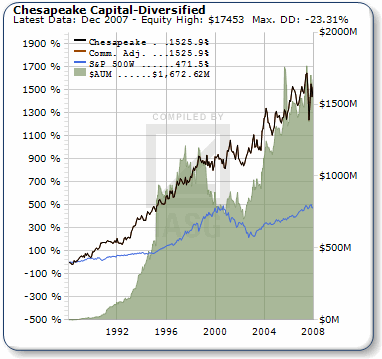
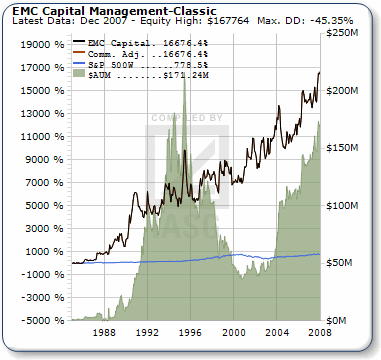
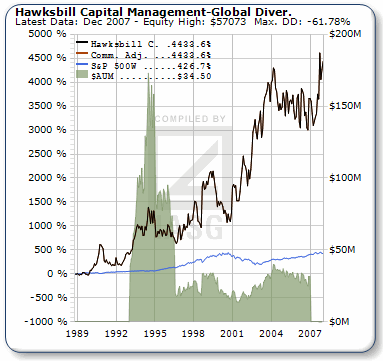
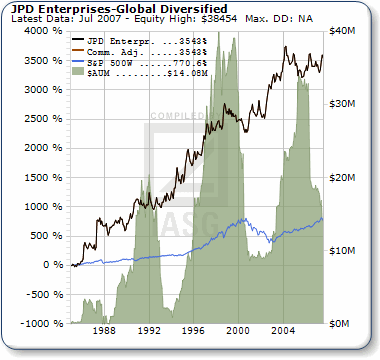
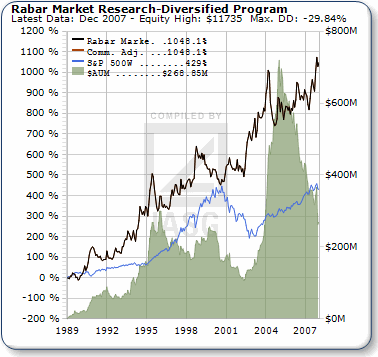
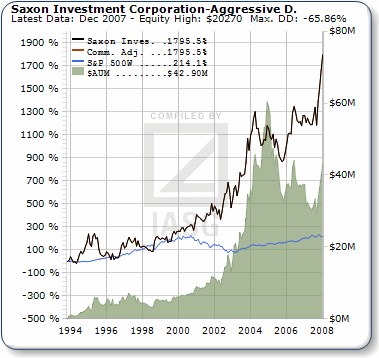
One of those six told me that the most successful Turtle in terms of performance since 1988 has been Jiri Svoboda, but Svoboda has no public fund to track and remains invisible. Other former Turtles such as Curtis Faith have portrayed an image of success, but in terms of trading to make millions this group of six is it.
So what separated them? Why such discrepancies? Why when they all had the same trend following trading rules did some Turtles not make it in the long run?
It might be comforting to think that Dennis had a careful screening process for intelligence and that that accounted for the Turtles trading success, but that would be an excuse. That said, many of the Turtles were very smart. So there is no intention here to slight their individual brainpower. However, a high IQ is hardly the key to success in life, or, for example, Enrons hundreds of MBAs from the top schools might have prevented its demise.
Intelligence ensures absolutely nothing in the long run; success requires something more. As it turns out, most CEOs at the biggest corporations didnt attend Ivy League schools. They went to state universities, big and small, or to lesser-known private colleges. Most people, would guess that the percentage of CEOs bearing Ivy League undergraduate degrees is far higher than the actual figure of only 10 percent.
So what, beyond pure intelligence, enabled Turtle Jerry Parkers twenty years of great performance? The Maginot line, between those Turtles who achieved huge trading success after working for Dennis and those who failed at trading, came down to an understanding and application of entrepreneurial skills. The Turtles had to have trading rules, but without entrepreneurial savvy they were doomed. Nancy Upton and Don Sexton, professors at Baylor University who have long studied entrepreneurs, pinpointed traits possessed by Parker and other entrepreneurs:
1. Nonconformists: lower need to conform indicating self-reliance.
2. Emotionally aloof: not necessarily cold to others, but can be oblivious.
3. Sky divers: lower concern for physical harm, but does change with age.
4. Risk takers: more comfortable taking it.
5. Socially adroit: more persuasive.
6. Autonomous: higher need for independence.
7. Change seekers: like novel approaches. This is different than 99% of all other people.
8. Energetic: higher need and / or ability to work longer.
9. Self-sufficient: don’t need as much sympathy or reassurance, but they still need to form networks so self-sufficiency need not be taken to extremes.
Those nine points are the real Turtle secrets. Dont underestimate them. Dennis turned on the lights and supplied the brokers, the money, and the system to the Turtles. But with Dennis out of the picture, the Turtles had to answer for themselves as to whether or not they had the ability and the desire to succeed on their own. Their dilemma, whether they knew it or not at the time, could be solved by how well they applied only those nine traits. Jerry Parker applied the nine traits out of the gate, which some Turtles proved unable or unwilling to do. Parker always had the self-confidence to believe that one day his earnings could rival those of Dennis. Other Turtles, when seeing firsthand Dennis earn $80 million in 1986, may have thought, “That could never be me.” A few confessed that they just felt lucky to be a Turtle, and when describing their peers some used words like timid or gun shy.
All traders should instantly have more confidence when they can look behind the curtain at real human behavior. There was much more to long-term success than just being an original Turtle armed with trading rules. The contrasts between the last 20 years of actions between Jerry Parker, the most successful of all Turtles and now arguably a billionaire, and Curtis Faith, who never traded successfully after 1988, may be the singular great lesson to be taken away from the Turtle experiment. The contrast between their success and failure is a lesson easily seen and understood by all. And now, thanks to those 9 factors, we have a way to not make the same mistakes ourselves.
Michael Covel is the author of the bestselling Trend Following. His latest book The Complete TurtleTrader is the first complete look at Richard Dennis famous turtle trading experiment. Covel has presented on the topic of trend trading and hedge funds from China to Japan to Europe to the United States. Covel is currently producing his first film documentary, an edgy look at investor behavior set for a 2008 theatrical release.
You can find more how-to and educational articles to improve your investing
and trading each day on TradingMarkets.com.
